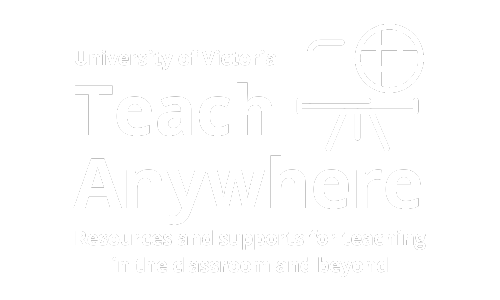The list below represents what a group of experienced UVic Teaching Assistants (TAs) have identified as key considerations to think about as you prepare for your first class as a TA, both online and in-person. Not all suggestions below may be applicable in all departments on campus. Please use the list as a guide only as this list is not exhaustive but encompasses a diverse array of considerations.
Speak to the course professor/coordinator
- Understand your role in the course
- Understand the objectives of the course
- Do not be afraid to ask all the questions you need; professors prefer that you do
- Know what the professor expects you to do and how to do it
- Speak to other TAs about their experiences
Review general course material and gather information
- Read the syllabus/course outline.
- Think about what students may ask about the textbook and course out line, or what questions will students have about help and resources available to them.
- Be aware of campus services for students (Centre for Academic Communication (CAC), LTSI Learning Strategists, Counseling Services, etc.).
- If running a lab, check equipment before the lab. This also applies to online environments: if your lab or tutorial takes place online, it may be worth it to rehearse and review functions such as breakout rooms and polls.
- Anticipate technical difficulties: for example, have a back-up plan ready in case the projector malfunctions or if students experience technical difficulties accessing online platforms (e.g., Brightspace, Zoom, or Microsoft Teams). In the case of the latter, the situation may be mitigated by sending out a pre-class survey to students about the devices they are using for their learning and connect students with the Computer Help Desk for any technical questions or concerns.
Identify where the room is located
- This includes knowing where the fire exit, washrooms, and safety equipment are located.
- If you are planning to project from a computer or are using any other technology familiarize yourself with how to set it up in the room in advance. Ensure you are familiar with equipment in the classroom if you need to use video, audio, etc.
- Confirm that you have access to the classroom.
Determine when your office hours will be
- Be reasonable for you and your students but do not be too flexible either.
- State what your e-mail response time will be (e.g., 24-48 hours is a reasonable length of time).
Devise a lesson plan for the first class (and every subsequent class)
- Give students an outline to follow for the class
- Plan your timing for the lesson (remember that it often takes longer than you anticipate)
- Make sure that information and instructions are written in comprehensible, concise language
- Ensure that students can access the information and instructions outside of the class as well
For the first class, here are some things you might want to keep in mind:
-
- Be clear on the expectations for your class
- Criteria for marking or grading
- Attendance
- Important dates: assignment due dates, evaluations, etc.
- Let students know how they can reach you outside of the class and how they can get your attention in class
- If you are in the virtual environment, it may be a good idea to go over the online platform functions
Think about how you want to motivate your students
How will you engage students who do not participate
- Think about creating multiple ways for students to engage with the class material – maybe written, verbal, online, or some combination thereof
- This way, students can engage in the class activities in a format and structure that works for them
What are some ways you can promote active learning?
- Think-Pair-Share: One minute quiet think, pair up and discuss for five minutes, then return to the large group and volunteers share out
- Jigsaw: Groups of four read a section or complete a task, then the groups are reshuffled so that one person from each of the four groups forms a new group and teaches to one another
- Turn questions back on the students – rather than answering the question yourself, turn the question back to the class to allow students to share (you want to encourage students knowing the answers and sharing their knowledge)
Rehearse and review your lesson
- Close your eyes and picture yourself in the classroom, standing in front of your students
- Rehearse what you are going to say to them
- Remember to speak slowly and clearly
- If you are teaching online, practice with the platform that you will be using
Respect students
- Give students the opportunity to make known their preferred name and pronouns
- Learn your students’ names
Have fun and relax! You got this!
This guide was developed during the Teaching Assistant Consultants’ (TACs) seminars for the academic year 2009-2010 and updated in 2020-2021.
